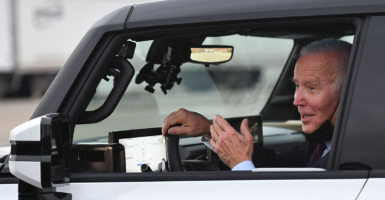The Biden administration and regulators in California are “trying to force the auto industry to convert its production of vehicles from gas-powered vehicles to electric vehicles,” warns Steve Bradbury, a distinguished fellow at The Heritage Foundation. (The Daily Signal is the news outlet of The Heritage Foundation.)
“And they really have in mind a ramp rate to do that that gets to 100% electric, all-electric cars and trucks, SUVs, pickups, your crossovers. All those vehicles that American families need and love would have to be all-electric by sometime in the middle of the 2030s,” Bradbury says.
“They also have that plan for big, heavy-duty trucks. That’s on a longer time frame,” says Bradbury, adding:
But they are beavering away, working as hard as they can to push this requirement through and actually force automakers to convert to electric vehicles much faster and much more broadly than market demand could possibly support.
Bradbury joins today’s episode of “The Daily Signal Podcast” to discuss three cases before the U.S. Court of Appeals for the D.C. Circuit—State of Texas v. EPA; Natural Resources Defense Council v. NHTSA; and State of Ohio v. EPA—as well as some of the issues raised in the three cases, and whether the cases could wind up before the Supreme Court.
Listen to the podcast below or read the lightly edited transcript:
Samantha Aschieris: Heritage Foundation Distinguished Fellow Steve Bradbury is joining today’s episode of “The Daily Signal Podcast.” Steve, welcome back to the show. Thanks for joining us again.
Steve Bradbury: Samantha, thank you. Great to be here.
Aschieris: The last time that you were on the show, we were discussing your report, “How to Fix the FBI,” but today we’re going to be discussing something a little bit different, and that is three cases before the U.S. Court of Appeals for the D.C. Circuit.
Now, on Thursday and Friday, the U.S. Court of Appeals for the D.C. Circuit heard arguments for State of Texas v. EPA, Natural Resources Defense Council v. NHTSA, and State of Ohio v. EPA. Now, you were in the courtroom for both days for these arguments.
Bradbury: Yes, long days.
Aschieris: I can only imagine. First and foremost, can you break down these cases for us, starting with State of Texas v. EPA?
Bradbury: Be happy to, Samantha. Thank you.
I think before I dive into the cases, I’m going to step back and give people the big picture. And this may be news to a lot of Americans out there, but every American should know what’s happening, what the Biden administration is trying to do and also, the regulators in the state of California.
They’re trying to force the auto industry to convert its production of vehicles from gas-powered vehicles to electric vehicles. And they really have in mind a ramp rate to do that that gets to 100% electric, all electric cars and trucks, SUVs, pickups, your crossovers, all those vehicles that American families need and love would have to be all electric by sometime in the middle of the 2030s. They also have that plan for big, heavy-duty trucks. That’s on a longer time frame.
But they are beavering away, working as hard as they can to push this requirement through and actually force automakers to convert to electric vehicles much faster and much more broadly than market demand could possibly support.
And the Biden administration is doing this on its own authority. Congress has never taken on this question and approved this mandate to force the industry to move to electric vehicles, to force Americans to have no options at the dealership but electric vehicles. So you’d no longer be able to find at the dealership new models of the vehicles that American families depend on and love so much, like your gas-powered pickups, SUVs, crossovers, and other vehicles.
As we know, historically, gas-powered cars have been the freedom machine for Americans. There’s some feeling of freedom and independence in having a tank full of gas in your car in the garage. Well, that would all go away in a world where we’re talking about 100% electric.
And of course, a lot of people are not going to be able to afford those electric vehicles and are not going to want to buy them, so they’re going to be stuck driving older and older used vehicles. And that is not safe.
NHTSA, National Highway Traffic Safety Administration, statistics show that older vehicles are less safe in highway accidents, so everybody understands safety is going to be sacrificed by this forced transition. Prices of all new cars are going to go way up. So, there’s a lot of negative implications.
There’s also, of course, the dependence on China, which processes the minerals for the electric vehicles and all that. So, these are huge questions of national importance, affecting the national economy, affecting American families in every market in the country and every state.
These are decisions congress should make for the nation. Congress is the elected representatives for the national government, which regulates interstate commerce.
So, where does the Biden administration get the authority to do this on its own? Well, it’s claiming the authority under old statutes that were passed in the 1970s that had nothing in mind with regard to forcing this transition to electric vehicles: the Clean Air Act and the Energy Policy and Conservation Act.
So under the Clean Air Act, EPA, the Environmental Protection Agency, is claiming authority to set emission controls, environmental limits on emissions of pollutants from the tailpipe of cars, at levels that are so low by regulation that they’re impossible to meet for traditional gas-powered vehicles.
And so, it’s going to force the industry, in order to meet these standards, to convert more and more of their fleet to electric vehicles, because then they look at the overall fleet and require a certain average for the fleet. So, that’s forcing the automakers to produce more and more electric vehicles to meet those standards.
Similarly, the Biden administration Department of Transportation through NHTSA, the National Highway Traffic Safety Administration, which is a component of DOT, is setting fuel economy standards. That’s the only agency in the whole government, federal or state, that has authority to set fuel economy standards for new vehicles. And they are setting those fuel mileage requirements similarly so high that the only way to meet them is to migrate your fleet more and more to electric vehicles.
Now they, in the case of NHTSA, by law, they are prohibited from taking into account the fuel economy of electric vehicles when they set those fuel economy standards. Those standards are supposed to be only for internal combustion engine vehicles. But here, NHTSA took into account the fuel economy of electric vehicles that are in the existing fleet in determining how much tougher they could make the fuel economy standards and how the automakers would respond. So, in setting the standards they took into account as part of the baseline these electric vehicles.
Then, the other thing that’s going on is California, [Gov.] Gavin Newsom has decreed—again, by executive order, just like President [Joe] Biden—that reality be damned, we are going to reach 100% electric new vehicles sold in California by 2035.
And his regulators at the California Air Resources Board, which sets climate regulations for California, is doing that by requiring automakers to sell increasing amounts of zero-emission vehicles, basically electric vehicles, until they reach that 100% in around 2035.
The only way California can set those regulations is if the Environmental Protection Agency at the federal level gives them a special waiver that allows them to do that. And that’s because Congress has said that the federal emission standards from pollutant emissions from tailpipes, the limits that the EPA sets, will be the exclusive limits for the nation and no state may set any different limits.
But they made this exception for California that allows the EPA to give California a waiver, so California can set its own stricter standards. But that requires the EPA to find that it’s necessary for California to do that because of compelling local issues, local environmental conditions in California.
And they’ve granted those waivers in the past, but it’s very different now when California gets a waiver to regulate for climate change purposes. Greenhouse gas emissions from the tailpipe, that really means carbon dioxide. If they can regulate carbon dioxide from the tailpipe, they can force the automakers to convert their whole fleet from gas power to electric. And that is what they’re doing, using that regulatory authority. EPA gave them that authority in the Biden administration by granting this waiver.
This waiver has been very contentious for years. Originally, the Bush administration denied it for greenhouse gas regulation, climate change regulation. Then the Obama administration granted it. Then the Trump administration withdrew it. And now the Biden administration has reinstated it. OK? And so it’s been bouncing back and forth. It’s very politically contentious. But there’s a real serious question of whether it meets the standard under the Clean Air Act for this waiver.
So these are the issues that are under challenge in these D.C. Circuit cases. So in the first case, it’s a challenge to the EPA’s tailpipe rules, which are trying to force the automakers to convert to electric by making the standards so tough you can’t meet them with an internal combustion engine, a fleet that’s all internal combustion engine.
The second challenge is to the NHTSA fuel economy standards, saying they are unlawful because NHTSA took into account electric vehicles when it considered what the standards should be.
And then the third challenge, which was argued just today in the D.C. Circuit, is the challenge to EPA’s decision to reinstate that special waiver for California.
And these challenges have been brought by state governments through their attorneys general. So led by Texas in challenging the EPA rule, led by Ohio in challenging the California waiver, and also by producers of fuel, refiners and other producers of fuel, and some other petitioners have been challenging it.
So there’s a number of issues raised in each case, and happy to walk through those issues.
Aschieris: Yes, that would be great if you could.
Bradbury: Sure. So these are big questions, really of huge consequence and of widespread economic effect and very fundamental legal challenges to each of these actions. The EPA tailpipe rules, the NHTSA fuel economy standards, and the California waiver, those are the three cases we’re talking about.
And the challenge to the EPA tailpipe rules is that this is a major question, whether EPA can use this Clean Air Act authority, which is, this is just authority to require automakers to reduce the pollution emissions from their motor vehicles.
And EPA is supposed to and traditionally has taken into account a balance between what can feasibly be achieved in terms of cleaner engine performance and fuel performance versus the effect on the interest in preserving positive or productive economic activity. Because there’s always a balance in economic regulation. And that’s what EPA has traditionally taken into account in setting standards for different pollutants.
But now that EPA has gotten into the business of setting limits on carbon dioxide emissions, claiming that that’s a harmful pollutant. Now EPA is making up standards for automakers to meet because you cannot have a gas-powered internal combustion engine vehicle that doesn’t emit carbon dioxide. I’m sorry, you can’t. OK?
So once you start setting limits on that, then you’re almost automatically talking, you’re on a pathway to potentially force the industry to convert its entire production process to making entirely new and different types of vehicles that are not based on an internal combustion engine.
So the fundamental legal question is, did Congress ever give EPA that authority to take this Clean Air Act statute that’s been used for decades to put reasonable limits on known pollutants and to start using it as a massive lever to force a huge transformation in the automobile industry, … part of our industrial base in the U.S., a fundamental part of our industrial base. Millions of Americans owe their jobs to the supply chain in one part or another of the auto industry in this country.
Americans love their cars, and we buy F-150 pickups and Ram pickups and these different kinds of very popular gas-powered cars. And what EPA is talking about doing is forcing that industry, not withstanding the wishes of America’s families, forcing it to change its production to electric vehicles so that that gradually will be more and more what you see at the dealership, and those options in those other vehicles will begin to disappear. So it’s a fundamental question.
The argument in challenging it is that that is what’s called a major question. And that’s a question fundamental to the national economy with major economic consequences and political implications. That is the type of question we would normally expect Congress to decide. And if Congress has granted an administrative agency—which is not elected, it’s just appointed. These are bureaucrats. They’re just not accountable directly to the American people. Theoretically, they’re accountable to the president, but they’re much less accountable than your elected representatives in Congress.
So if Congress intended to give this huge kind of power to this federal agency, we would expect that grant of authority to be very clear in the statute. And that’s what the Supreme Court has said recently in West Virginia v. EPA and other major questions doctrine cases, “On issues of major questions with huge consequences, we will require a clear statement in the statute that the agency has the specific authority to do what it’s claiming to do.” So that’s a big issue in challenging the EPA’s rule.
Even apart from the major question doctrine issue, another big question is whether EPA can regulate electric vehicles as part of the class of motor vehicles. But EPA itself says they don’t emit any of the pollutants that EPA has authority to regulate. They don’t even have tailpipes.
So this is a rule for putting limits on pollution from tailpipes. And they’re including in the class of vehicles that they are regulating vehicles that don’t have any tailpipes and they say don’t emit any pollutants. And yet, they’re putting them all together with the gas-powered vehicles and saying, “This is how you have to satisfy this rule.” In other words, you have to start making more and more of these other types of things.
And then what they do is they put that whole universe of vehicles together, both electric and gas-powered, and they say, “We’re going to apply our standards by averaging the standards across the fleet.” And you see what they’re doing there. By including electric vehicles in the pool and then saying, “We’re going to apply it by averaging,” you’re essentially creating a mechanism to force the industry gradually to produce more and more electric vehicles and fewer and fewer gas-powered vehicles.
In fact, just this year, EPA has proposed a new rule for the following for further years into the future because these rules apply by model year of new vehicles. So they’re going out further in the future.
The current rule they’re just now proposing, they haven’t finalized it yet, so it’s not yet in court. It’ll be challenged too, next year. But it hasn’t been finalized yet. They’ve just proposed it. But they’re going even further in the new rule.
And it’s very obvious that they’re using this mechanism as kind of a sliding scale or slide rule to sort of force the industry more and more to produce electric vehicles to try to reach those goals that Joe Biden and Gavin Newsom have laid out.
So that’s the challenge to the tailpipe rule. That was argued yesterday. Taking the lead was the fuel producers in challenging that. And it was defended by the Justice Department, representing the EPA. Also, it was challenged by the state of Texas. And the deputy solicitor general for the state of Texas argued … there challenging the EPA’s rule.
The second rule, which is under challenges, the NHTSA fuel economy standards, these are the fuel economy standards that NHTSA finalized last year and they go through model year 2026. Again, NHTSA has, just two weeks ago, or a few weeks ago, proposed a new set of fuel economy standards that go out further into the future from model year ’27 to ’31, so it’s more of the same.
But this challenge to the NHTSA standards is focusing on that provision that I mentioned earlier, that in the statute that NHTSA applies, that prohibits NHTSA from considering the fuel economy of electric vehicles when they set fuel economy standards for internal combustion engine vehicles.
And the claim is that NHTSA violated that prohibition, that restriction, by doing what I think I described, which is considering the electric vehicles that are out there in the world as part of the baseline for performance of fuel economy achieved today in order to build on top of that and determine how much further they could go. And in this rule, wow, did they go further.
They took what we had done during the Trump administration and then they bumped it up greatly by increasing the required fuel economy performance for new vehicles by 8% for one year, 8% for the next year, and 10% for the third year. So, over three years they bumped it up 26%. It’s huge increase and just impossible, just really impracticable, not feasible, which are the standards they’re supposed to apply. Is it technologically feasible? Is it economically practicable?
It’s not for internal combustion engine vehicles to meet these standards. There’s no way the automakers, as in terms of their whole fleet across the country, can meet these average requirements without beginning to migrate their production more and more than they already do to electric vehicles.
So, NHTSA is using its fuel economy standards to do exactly what EPA has been trying to do. And the major thrust of the argument challenging that is that they violated this provision by taking into account fuel economy of electric vehicles.
I think that argument seemed to resonate with the court yesterday and so we’ll see how that goes. The panel, there was one panel of three judges that heard both of those cases yesterday, and these are accomplished judges who sit in the, this is the second-highest court in the country, the U.S. Court of Appeals for the D.C. Circuit. This is the court where Justice [Antonin] Scalia came from, Justice [Clarence] Thomas, Chief Justice [John] Roberts, Justice [Brett] Kavanaugh, Justice Ketanji Brown Jackson, and others who come from this court.
So, the judges on this court are very accomplished and the chief judge of the court was on the panel, Sri Srinivasan, appointed by President [Barack] Obama. Then Judge Greg Katsas, who was appointed by President [Donald] Trump and a pretty new judge; Judge Florence Pan, who is appointed by President Biden. She actually took the place on the court of Judge, now-Justice Ketanji Brown Jackson. So, I think it’s fair to say that the panel was a pretty tough panel for the challengers, but we’ll see.
It’s always hard to predict how courts come out on particular cases, very complicated such as these cases. And these are big issues of national importance, massive economic consequences, freedom of all Americans to have those gas-powered cars. We love issues that are going to continue to percolate. So, however this panel of judges decides these two cases, I think these issues will continue.
They may ultimately be decided by the Supreme Court, particularly if they’re recognized as major questions. Ultimately, Congress is going to need to decide these issues for the United States. That’s really the only proper way for issues like this to be decided.
Today’s case, the one that was argued just this morning, was the challenge to the California waiver that was granted by EPA. That challenge was brought principally also by the fuel producers, refiners and fuel producers, but also by the state of Ohio. And the solicitor general for the state of Ohio argued that case, Ben Flowers, and then representatives for the fuel producers as well.
The challenge there is mainly that EPA cannot grant a waiver to California that allows it to do this greenhouse gas regulation of vehicles and require zero-emission vehicles because the whole purpose of that regulation is to address what is claimed to be a global climate issue, for which the effects are not unique to California, and the effects in California are not unique versus other states or really any other location on the face of the globe.
These are global issues. That’s the whole argument of the climate change policy push. So, the claim is that EPA could not do what the statute requires it to do, and that is to find that the waiver’s necessary to allow California to put in place regulations that it needs to put in place because of compelling conditions in California. And EPA has a breathtakingly broad interpretation of its authority to grant California this waiver.
EPA says, “As long as California can show it still has a need to have its own regulations”—and this is primarily granted to it because it has a particularly bad, historically bad problem with smog in the LA Basin area. “And as long as California needs its own program because of smog in LA, we’re going to grant it a waiver to issue any kind of rules it feels it needs to issue no matter what. And we don’t have to check on whether the particular standard it wants to issue now and what’s at issue here is the requirement to convert to zero-emission vehicles. We’re not even going to ask whether it has a need because of compelling local conditions to put in place that requirement.”
They just say they don’t even have to ask that question, as long as California continues to have bad smog and has a need for a program generally.
The effect of these California regulations is even broader and more Draconian than what the Biden administration is trying to do directly through its own federal rules.
This would require, as I said, as Gavin Newsom has ordered, all the automakers that sell new vehicles in California—which is all the automakers that sell in the U.S., you can’t sell in the U.S. and avoid the California market, it’s the biggest car market in the country—that all the automakers that sell vehicles in California have to convert to 100% electric by 2035.
It’s not in any way going to be limited to California.
First of all, any other state under this federal statute can elect to apply California’s rules in their own state if they have some clean air issues, problem areas. And more than a dozen blue states have done that, representing a large fraction of the U.S. population.
And then in addition, the economics of the California market being so big and significant and add on these other states—and we’re talking about states like New York, New Jersey, Pennsylvania, Massachusetts. The automakers have no choice economically but to convert their production to electric to meet these standards.
The automakers are not complaining, by the way, about this rule, not in this go around. I think what EPA is doing in the current proposal, the new rule has gone so extreme that even the automakers there are complaining about it. But in the cases that are currently before the court, the automakers are not challenging what California’s trying to do and what EPA has done.
And I think that’s because they just want to sell vehicles. And even though you want to buy a gas-powered vehicle, hey, if they can sell you an electric vehicle or force you to buy it, they’re just as happy. Particularly, they can get more money for the electric vehicles. They can charge more, they cost more.
But they need the assist of government to force that change because the big problem they have is consumers in the U.S. are not flocking to these electric vehicles. So they’re going along with this heavy-handed regulation and leaving the challenge to the fuel producers in the states that are unhappy about this.
Some of the states today were arguing—this is Ohio’s argument, that it violates their sovereignty interests for the EPA to grant this one state, California, this unique power over the rest of the economy and every other market in the country and every other state. That’s a pretty compelling argument.
I will say, in both of these cases, there are threshold issues that often crop up in these complicated administrative law cases where the government is challenging the standing of the parties to raise certain arguments or claiming that they didn’t preserve the arguments by making them before the agency.
So there are these complicated threshold questions that could complicate the outcome. Those are always somewhat tricky. And so there’s a lot of argument today and yesterday navigating through those.
Today’s case, which is the Ohio v. EPA case challenging the California waiver, that was before three judges—a different panel of judges. That was Judge Robert Wilkins. He was appointed to the D.C. circuit by President Obama. And Judge Michelle Childs, she was appointed by President Biden. And then finally, a pretty new judge, Judge Brad Garcia, who was also appointed by President Biden.
But I do think there seemed to be a good amount of interest by the panel of three judges today for this argument that California needs to look at each standard. It can’t just look at the overall program and say, “Oh, they still have a need for the program. So that’s enough.” But we’ll see. Again, I make no predictions on how it comes out.
But the waiver that the EPA has granted to California in this case when it comes to climate change regulation, carbon dioxide emissions from motor vehicles, nothing could be broader and more powerful.
So they’re just handing California’s regulators a carte blanche authority to change the automotive landscape, convert the whole auto industry in the U.S., change all of the choices that American families have available at the dealership in terms of new motor vehicles across the country from coast to coast. Incredible power, enormous economic power and political power, really, that EPA has handed to California.
So again, I would say the case of the legality of this kind of waiver and whether the statute really gives EPA the authority to hand California this blank check, I could see this again being the kind of issue that might make its way at some point to the Supreme Court.
I have to say that just yesterday the House of Representatives passed a bill called HR 1435, which is the preserving … consumer choice at the dealership bill. And it would prohibit EPA from granting these waivers to California, to give California authority to limit or prevent the sale of internal combustion engine vehicles, and would also require EPA to revoke these types of waivers that have previously been granted during the Biden administration.
Some very important legislation. It’s hard to speculate how it might fare in the Senate, but it just passed the House of Representatives yesterday. This was authored by Congressman John Joyce of Pennsylvania. So got to give a shoutout to the House of Representatives for taking on this issue.
Unfortunately, as often happens with these matters of the administrative state and the growth of the administrative state and the power of regulators and bureaucrats who aren’t elected, part of the problem resides in the fact that our elected representatives in Congress have not really been doing their job. They’ve not really been taking on these big issues that really only Congress should decide for the American people. That’s the way our Constitution is supposed to work.
They’ve not been taking on those issues. And they’ve sort of been sitting back when it comes to big controversial questions like these and been content to let the bureaucrats in the administrative agencies decide the questions. Again, usually under statutory grants of authority that go back many years that were given to those agencies at a time when Congress never contemplated this kind of use of those powers.
So that’s really what’s at stake. It gets fundamental to our constitutional system, to the growth and power of the administrative state, and the coercion that regulators are using to try to force change in the name of the “green dream” climate policies and other goals like that. And these cases are really at the heart of that and they’re complicated, but it’s important for the American people to understand what’s happening, at least in a big-picture level.
Aschieris: Well, Steve, thank you so much for breaking down these cases for us. It’ll be really interesting to see the outcomes of them. We’d love to have you back on to discuss when we do get those decisions, the significance of them. And yeah, thank you so much for joining us. I really appreciate it.
Bradbury: Samantha, great. I’m glad to be here and thank you.
Have an opinion about this article? To sound off, please email letters@DailySignal.com, and we’ll consider publishing your edited remarks in our regular “We Hear You” feature. Remember to include the URL or headline of the article plus your name and town and/or state.





























